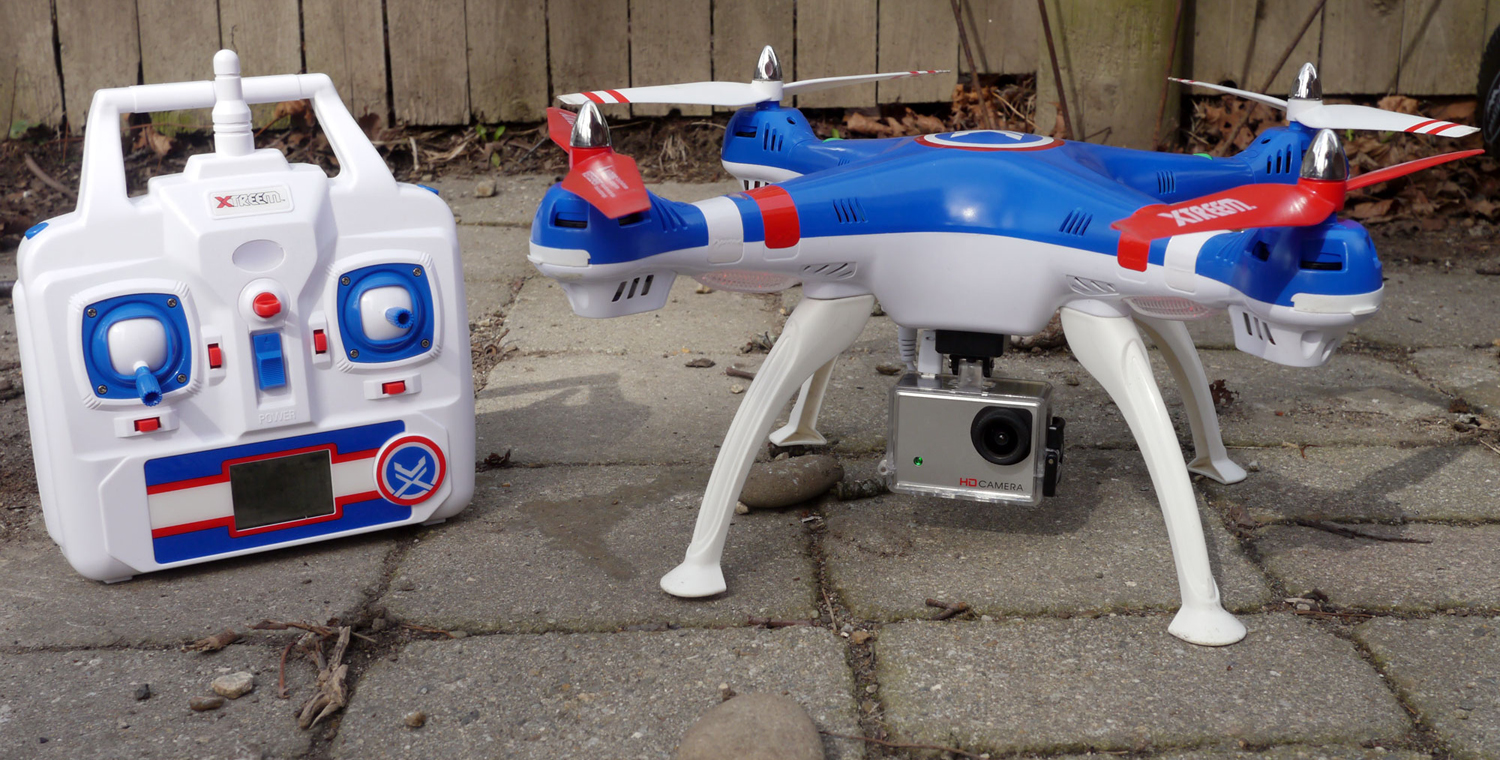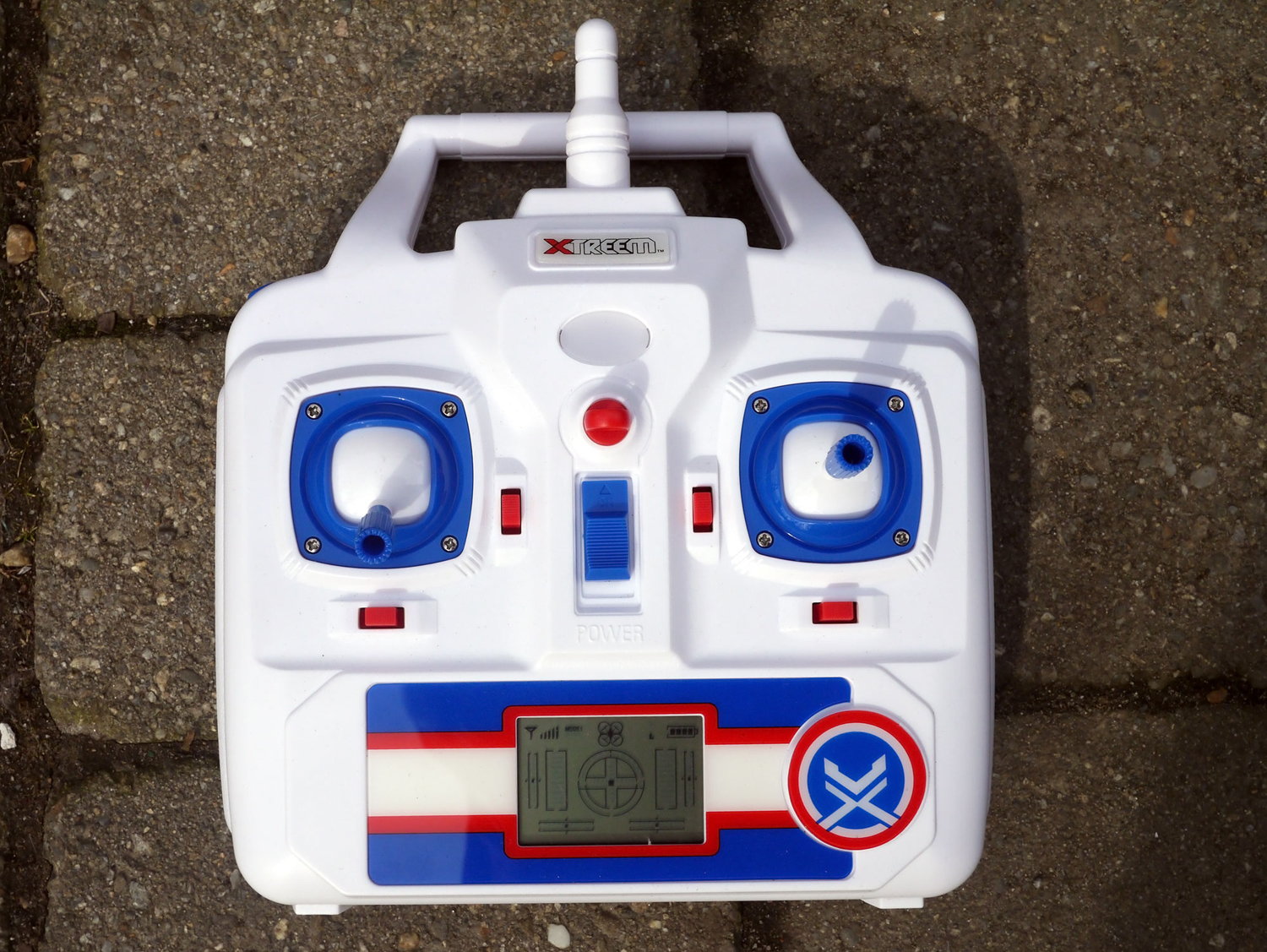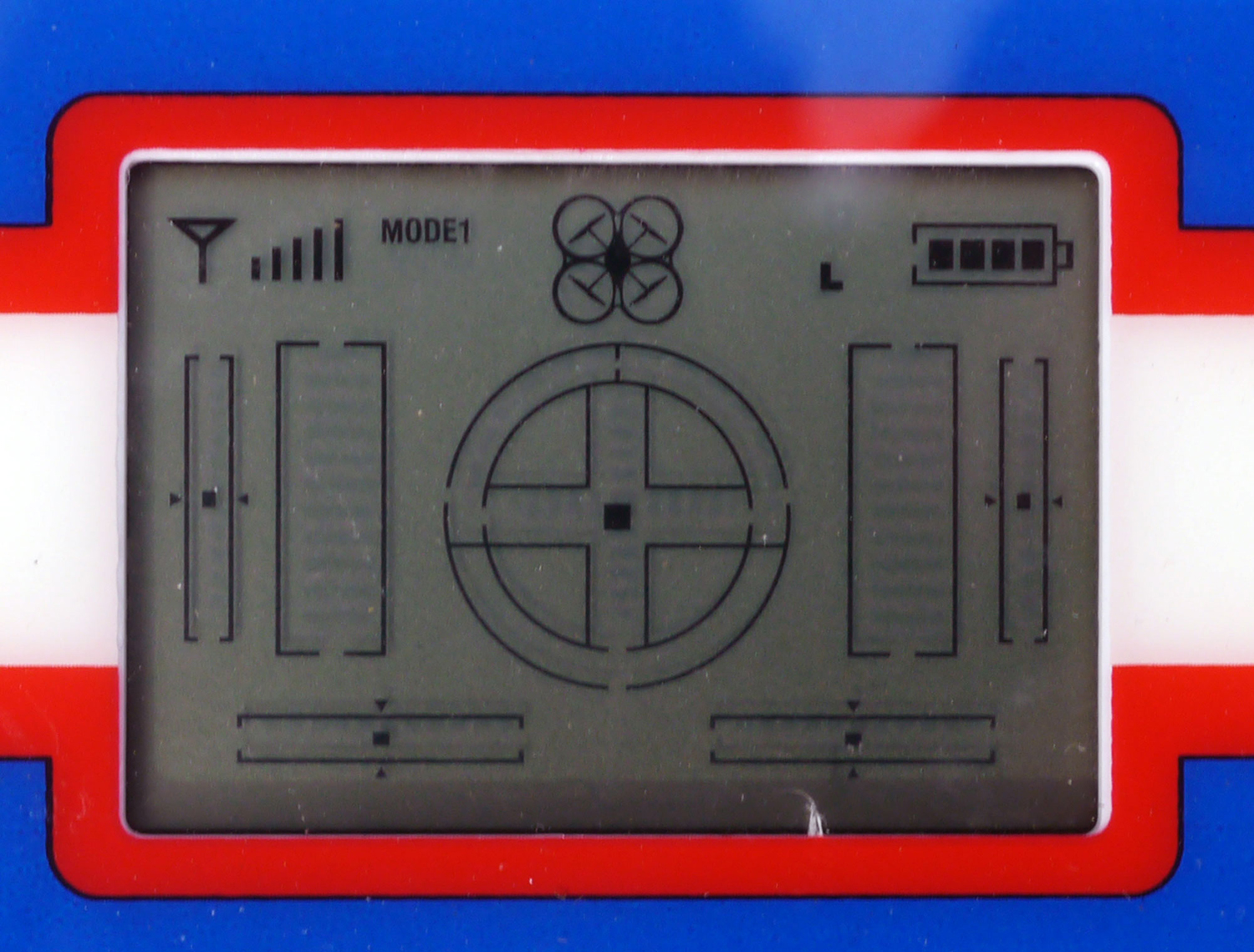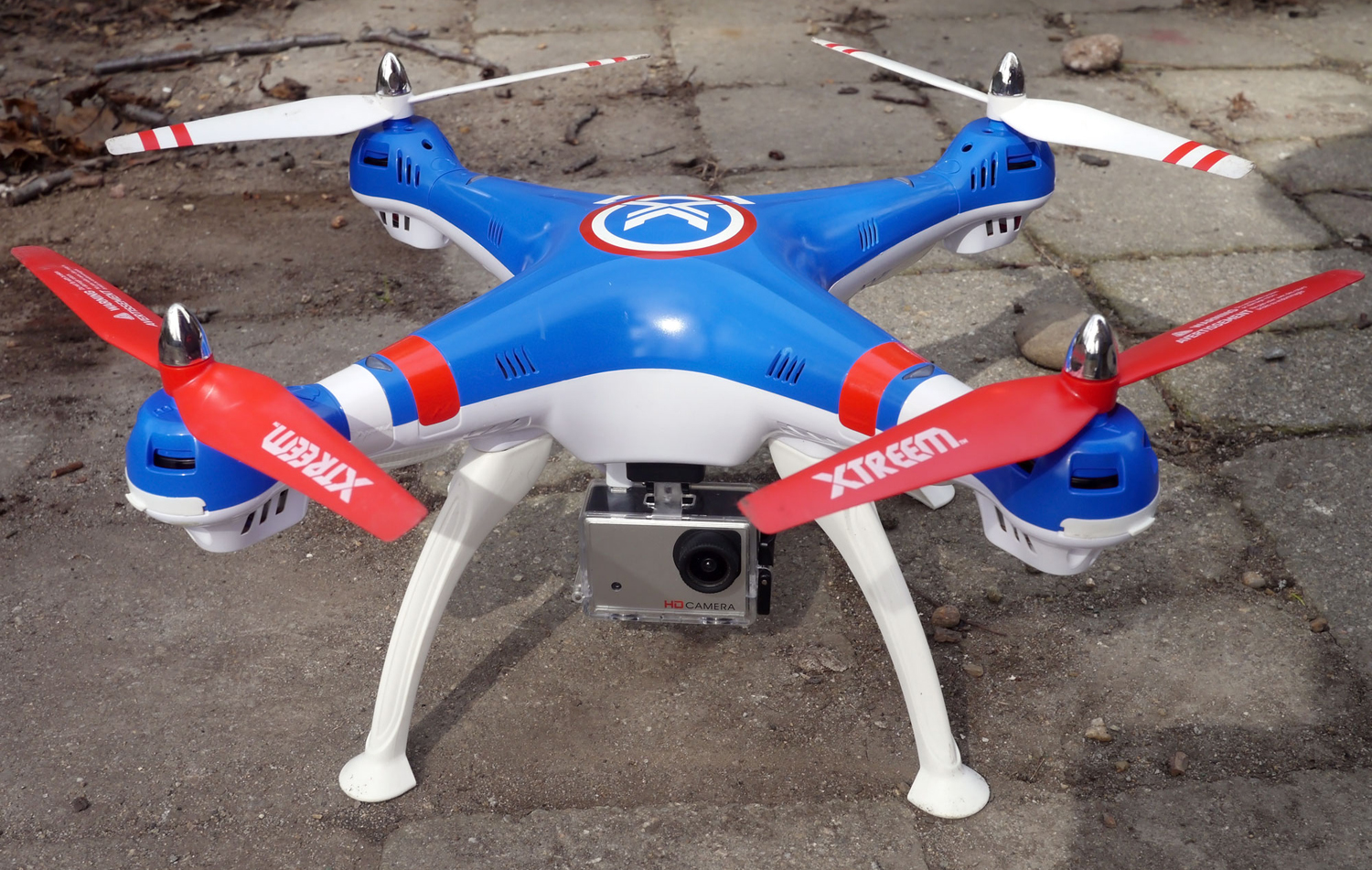Tom's Guide Verdict
The Swann Xtreem Gravity Pursuit is a simple, inexpensive drone that takes decent video and is fun to fly.
Pros
- +
Captures HD video
- +
Comfortable controller
- +
Inexpensive
Cons
- -
Mediocre video quality
- -
Difficult to hover and make small maneuvers
- -
No video preview
Why you can trust Tom's Guide
Many people love the idea of a video drone: After all, who wouldn't want to record the view from the air? But they aren't cheap: A drone like the DJI Phantom 3 can set you back $700 or more. Answering the call of the budget conscious, the Swann Xtreem Gravity Pursuit shoots HD video for $250. But although it's a fun drone to fly, it's a compromise: You'll have to go without GPS, automated flight, a video preview and other fancy features, such as autonomous flight.
Design
The Xtreem Gravity Pursuit certainly stands out: The bright, blue-and-white plastic case sports red front rotor blades and white back blades, for a patriotic look. Military-style decals on the body also help orient the drone's direction.
It's not a small drone, though. Measuring just less than 20 inches from rotor tip to rotor tip, it is one of the larger drones in this price range. Although it is a pretty light drone for its size, it does need to be registered with the FAA, as the 1.4-pound weight puts it over the 0.55-pound minimum weight for flying below the radar of the law.
Four very bright LED lights on the underside of the motor arms add to the sense that this is just a large toy. Not that there is anything wrong with that. This is not a drone designed for flying without upsetting the neighbors; it is a fairly large, noisy drone that people will notice. The drone includes four legs that must be screwed to the base of the drone manually. Unfortunately, the legs are made of a different color plastic than the base, which looks somewhat incongruous.
On the end of the motor arms are the rotors, large 9.5-inch diameter blades that make a lot of noise in flight. (This has to be one of the noisiest drones for its size that I have tested.) Also included are four rotor protectors, which attach with screws to the end of the motor arms to protect the rotor blades from tree branches and other obstacles. These won't do much to protect any curious fingers or other appendages that get in the way, though, so keep this quadcopter away from small children and animals.

The unbranded camera clips onto the bottom of the quadcopter base, with a locking connection to the camera holder, and a single cable that powers and controls it. The camera holder does allow you to tilt the camera down by adjusting a screw, but you can't adjust this in flight. The mount doesn't offer any stabilization or insulation from the vibration of the quadcopter body.
The simple camera captures 1080p video or 8-megapixel images. The controller can select still or video modes. A small switch on the side of the camera body also switches between 1080p or 720p video. You can remove the camera from its holder by unlocking a simple latch, and a micro-USB port allows you to connect it to a computer for retrieving video and images. These are stored on a microSD card that fits into the side of the camera; a 4GB card is included that can hold about 35 minutes of video. (The drone flies for only 12 minutes on a charge.) It supports cards up to 32GB.
MORE: Drone Buying Guide: Everything You Need to Know
No micro-USB cable is included, but the Gravity Pursuit does feature a USB microSD card reader. The camera can't be swapped out for a better one; only the included camera works with this drone.
Specs
Rotors: Four 9.5-inch removable rotors. One spare set included.
Battery Size: 7.4V 2,000-mAh Li-Ion (quadcopter), 4XAA (remote)
Battery Life: 12/12 minutes (claimed/tested)
Camera: 1080p/720p video, 8-megapixel stills.
Smartphone Controlled: No
FAA Registration: Yes
Size: 19.7 x 19.7 x 7.5 inches
Weight: 1.4 ounces (including battery)
Controller
The controller shares the colorful design of the quadcopter itself, with a white case and bright-blue highlights. It's pretty basic, with two control sticks, a handful of switches around them, two shoulder buttons and a small LCD screen at the bottom. There is no color screen or video preview here; this screen just shows information about the quadcopter. There are no return-home or GPS navigation features; the pilot is in control from takeoff to landing.

The two shoulder buttons give you access to some fancy features, though. If you hold the right one and move the left control stick, the quadcopter does a somersault. The left shoulder button provides access to the different flying modes (which offer different speed limits) and something called instinctive mode (more on this later).

The trim switches can correct for the tendency of the quadcopter to drift, but they also double as mode controls. The horizontal trim switch, for instance, takes a photo or starts recording video. You press it down once to start/stop a video, or press and hold it down to adjust the trim. This can be somewhat confusing; I found myself inadvertently adjusting the trim rather than starting a video because I didn't release the switch quickly enough.
Flying
While the controls are light and responsive, flying the quadcopter feels jittery, requiring close attention and constant adjustments to keep it level. It has a decent amount of power and can manage about 15 to 20 mph. It can climb and turn aggressively, but subtle movements are more difficult to judge. The quadcopter tends to go from not moving to moving fast with even a slight twitch of the control sticks.
Even a light breeze will push this lightweight drone off course, so having it hover in one spot on all but the stillest days requires constant adjustments and then compensation for any overadjustment you made that tipped the quadcopter into moving. The quadcopter itself doesn't do any correction; there is no GPS or other way for it to loiter in a particular spot. This also means that if you send it zooming off, it will keep going once the signal is lost — so you need to be careful to keep it in signal range.
The Gravity Pursuit is more at home zooming around, though, and it is fun to fly. It can also do a 360-degree flip by holding down the right shoulder button and moving the right stick, with the direction of the stick determining which way it flips. This maneuver does require a lot of space, though, as the quadcopter loses a lot of height while flipping. The manual recommends you have it at least 3 meters (about 10 feet), and that's on the optimistic side — you stand a good chance of crashing the quadcopter if it isn't at least 15 feet in the air.
Photos and Video
The Gravity Pursuit captures 1080p high-definition videos and 8-megapixel still images, but HD video is of no benefit if the video quality isn't good. And this drone struggles with that; the photos and videos are not great. That's not unusual for cheaper drones like this, though. Similar drones, such as the Parrot AR.Drone 2.0, produce similar-quality video.
The 1920 x 1080 videos are shot at 30 full frames per second and are saved to the included 4GB microSD card. The card can hold about 35 minutes of video, which is enough for nearly three battery-killing flights. However, this does mean that the video is very heavily compressed, and this shows in the final product. Both moving and hovering result in terrible images.
In both 720p mode and 1080p mode, the video looks noisy. If you look at an area of flat color, you'll see grainy, speckled patterns caused by camera noise, especially in low light. The heavy compression also means that when the quadcopter is moving fast, the video turns into a blurry mess. When the quadcopter is hovering, you get camera shake. This shake makes things look not only blurry but also like they are underwater. Straight vertical lines become wobbly, which makes things like trees or power poles look wavy rather than straight.
However, if you keep the drone straight and level, and maneuver slowly and carefully on a still day, these problems are lessened. The Gravity Pursuit can capture decent video, just not when you are throwing it around the sky like a combat pilot.
For some reason, the Gravity Pursuit also captures audio, which most drones don't do. That's because it sounds like a horror film where a masked assassin is hacking their way through a horde of the undead with a lawnmower. Seriously, it is a deeply unpleasant and unsettling sound. Unfortunately, there is no way to disable this, so remember to turn off your speakers before playing the video back if you don't want to freak out your viewers. Videos are broken up into 5-minute chunks of files, but the quadcopter keeps recording until it runs out of space or you stop it.
Although the video that the Gravity Pursuit captures isn't perfect, it is better than that recorded by cheaper drones such as the UDI U818A, and it definitely is good enough to capture a nice view or to make out distant details. It can't come close to the video quality of the Parrot Bebop 2 or the DJI Phantom 3, but it is also much cheaper than both of those drones. If you want video you can be proud of, spend more on these better drones.
MORE: What the FAA's Drone Rules Could Mean for You
Repairability
The Xtreem Gravity Pursuit is a pretty tough drone. We crashed it numerous times in our tests, but it didn't sustain any serious damage, thanks to its lightweight and tough construction. The rotor blades are most likely to break, and a replacement set of four rotors costs $10. One spare set is included with the Gravity Pursuit. These are easy to replace: You simply twist off the silver bolt on top of the motor, remove the retaining lug and replace the rotor. Replacement legs and prop guards are also available, for about $30 each.
Battery Life
The Gravity Pursuit is powered by a 2,000-mAh lithium-Ion battery that fits under a locking cover on the center of the frame. We found that this lasted for about 12 minutes of flight time, which is about what the manufacturers claim. Spare batteries are available for about $40, and the battery uses standard connectors, so off-brand batteries can be used. The included charger is rather slow, taking a lengthy 55 minutes to fully recharge a single battery.
Bottom Line
The Swann Xtreem Gravity Pursuit is a fun quadcopter to fly, and it takes acceptable video for the price tag. But there are a lot of compromises you'll have to make. The quadcopter is noisy and awkward to control. There is no video preview on the controller or a smartphone, and the quadcopter is noisy and blurry in flight. The lack of image stabilization also means that it gets blurry and shaky while the quadcopter is in flight, which is very off-putting to the viewer. But these are acceptable compromises, as long as you buy it knowing that you aren't going to get documentary-quality video from it.
Richard Baguley has been working as a technology writer and journalist since 1993. As well as contributing to Tom's Guide, he writes for Cnet, T3, Wired and many other publications.

